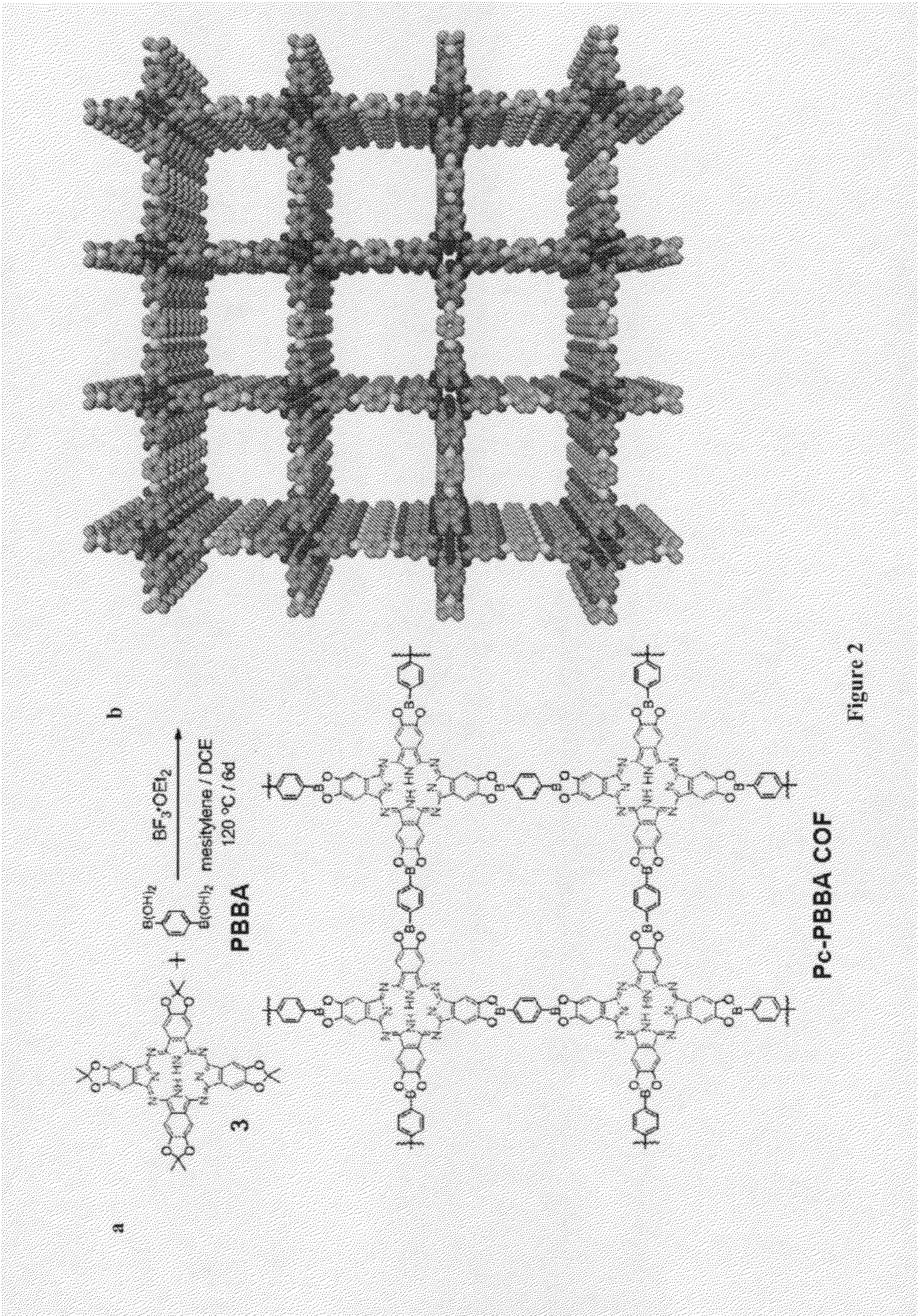Covalent Organic Frameworks and Methods of Making Same
a covalent organic and framework technology, applied in the field of covalent organic frameworks, can solve the problems of limited generality of molecular design strategies, unsolved challenges, and inability to reliably predict the crystal structure of small organic molecules, and achieve the goal of fully realizing their potential , the limited generality of synthetic methods for cofs represents a significant roadblock
- Summary
- Abstract
- Description
- Claims
- Application Information
AI Technical Summary
Benefits of technology
Problems solved by technology
Method used
Image
Examples
example 1
[0066]In this example a general method for the synthesis of boronate ester-linked COFs that avoids the direct use of insoluble and unstable polyfunctional catechol reactants is described. Using this method, two-dimensional networks of cofacially-stacked phthalocyanines (Pcs) have been prepared, strongly absorbing chromophores that have been employed in both bulk heterojunction and dye-sensitized solar cells, as well as for many other applications. The phthalocyanine COF forms an eclipsed two-dimensional square lattice as determined by powder x-ray diffraction, surface area analysis, and UV / Vis / Near IR and fluorescence spectroscopies. This material can be used in forming COF-based bulk heterojunctions featuring structurally precise and high surface area interfaces between complementary organic semiconductors.
[0067]The direct formation of boronate esters from protected catechols presents an attractive alternative for COF synthesis because the protecting groups can decrease the compoun...
example 2
Examples of COFs
[0105]The structures of the COFs in this example are depicted in FIG. 32. ZnPc-PDBA COF. Pyrene diboronic acid 1 (17 mg, 0.059 mmol) and zinc octahydroxyphthalocyanine 5 (20 mg, 0.028 mmol) (see FIG. 33) were combined in a mixture of dioxane and methanol (2:1, 3 mL) and sonicated for 10 minutes. The dark green suspension was transferred to a 10 mL pre-scored long-necked glass ampoule, flash-frozen in a liquid nitrogen bath, and flame-sealed. The ampoule was placed in a 120° C. gravity convection oven for 96 hours, and the resulting free-flowing dark green powder was collected by filtration on a Hirsch funnel, washed with 1 mL anhydrous toluene and air-dried. Brief drying under vacuum was immediately followed by characterization by PXRD and IR. Isolated yield of ZnPc-PDBA COF 10 mg (52%). IR (powder, ATR) 3233, 1607, 1459, 1369, 1337, 1271, 1231, 1106, 1078, 1023, 902, 870, 824, 742, 714 cm−1. PXRD [2θ (relative intensity)] 3.22 (100), 6.50 (24), 9.92 (5.6), 13.16 (4....
PUM
| Property | Measurement | Unit |
|---|---|---|
| Temperature | aaaaa | aaaaa |
| Temperature | aaaaa | aaaaa |
| Diameter | aaaaa | aaaaa |
Abstract
Description
Claims
Application Information
 Login to View More
Login to View More - R&D
- Intellectual Property
- Life Sciences
- Materials
- Tech Scout
- Unparalleled Data Quality
- Higher Quality Content
- 60% Fewer Hallucinations
Browse by: Latest US Patents, China's latest patents, Technical Efficacy Thesaurus, Application Domain, Technology Topic, Popular Technical Reports.
© 2025 PatSnap. All rights reserved.Legal|Privacy policy|Modern Slavery Act Transparency Statement|Sitemap|About US| Contact US: help@patsnap.com



